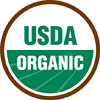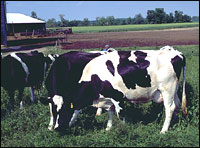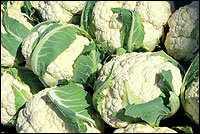The Bush administration is giving Americans new reason to watch what they eat — and it’s got nothing to do with carbs.

Sealed with a hiss?
Over the course of 10 days in mid-April, the U.S. Department of Agriculture issued three “guidances” and one directive — all legally binding interpretations of law — that threaten to seriously dilute the meaning of the word organic and discredit the department’s National Organic Program.
And the changes — which would allow the use of antibiotics on organic dairy cows, synthetic pesticides on organic farms, and more — were made with zero input from the public or the National Organic Standards Board, the advisory group that worked for more than a decade to help craft the first federal organic standards, put in place in October 2002.
The USDA insists that the changes are innocuous: “The directives have not changed anything. They are just clarifications of what is in the regulations that were written by the National Organic Standards Board,” USDA spokesperson Joan Shaffer told Muckraker. “They just explain what’s enforceable. There is no difference [between the clarifications and the original regulations] — it’s just another way of explaining it.”
But Jim Riddle, vice chair of the NOSB and endowed chair in agricultural systems at the University of Minnesota, argues that what the USDA is trying to pass off as a clarification of regulations is actually a substantial change: “These are the sorts of changes for which the department is supposed to do a formal new rulemaking process, with posting in the federal register, feedback from our advisory board, and a public-comment period. And yet there is no such process denoted anywhere.”
Organic activists suspect that industry pressure drove the policy shifts. They point out that the USDA leadership has long-standing industry sympathies: Agriculture Secretary Ann Veneman served on the board of directors of a biotech company, and both her chief of staff and her director of communications were plucked right out of National Cattlemen’s Beef Association.
“Even though it evolved as a reaction against large-scale American agribusinesses, the organic food industry has seen tremendous growth, roughly 20 to 24 percent a year for the past 10 years,” said Ronnie Cummins, founder and national director of the Organic Consumers Association. “That, not surprisingly, has brought with it investments from big business and demands for conventional farming practices more favorable to mass production.”

How now, organic cows.
Photo: USDA.
One practice favored by large agribusiness is the use of antibiotics on cows, and a guidance [PDF] issued on April 14 will allow just that on organic dairy farms, a dramatic reversal of 2002 rules. Under the new guidelines, sickly dairy cows can be treated not just with antibiotics but with numerous others drugs and still have their milk qualify as organic, so long as 12 months pass between the time the treatments are administered and the time the milk is sold.
“This new directive makes a mockery of organic standards,” said Richard Wood, a recent member of the FDA’s Veterinary Medicine Advisory Committee and executive director of Food Animal Concerns Trust. “Organic farmers that we have talked to are furious because they have been very careful to follow the antibiotics rule. [The rule change] undercuts their ability to make a living doing things right.”
Furthermore, said Wood, the use of antibiotics will reduce the pressure on organic farmers to provide healthy accommodations for their livestock. If they know they can pump their animals up with drugs, they won’t have to worry so much about disease spreading when cows are penned up in close quarters, or about weaning calves from their mothers at an unnaturally early age.
“It’s hard to deny that this looks awfully like a political move by USDA to do the bidding of larger dairy operations that want to produce organic milk by expanding their herds with cattle that were once on non-organic farms,” Wood said.
Another new guidance [PDF] put out on the same day would allow cattle farmers to feed their heifers non-organic fishmeal that could be riddled with synthetic preservatives, mercury, and PCBs and still sell their beef as organic.
And the following week, on April 23, the USDA took the particularly egregious step of issuing a legal directive [PDF] that opens the door for use of some synthetic pesticides on organic farms.
Previously, organic farmers were only allowed to use natural, non-toxic pesticides on their crops, which effectively prohibited use of pesticides with hidden ingredients (pesticide manufacturers often don’t list certain ingredients, claiming the information is proprietary).

How does your cauliflower grow?
Photo: USDA.
According to the new guidelines, however, organic farmers and certifiers are only required to make a “reasonable effort” to find out what is in the pesticides being applied to crops. “If they can’t come up with the info on toxic inert ingredients that may be in their pesticides, they’re off the hook” said Liana Hoodes, organic policy coordinator for the National Campaign for Sustainable Agriculture. “This takes all the pressure off of pesticide manufacturers to reveal their ingredients and develop non-toxic products. In fact, it creates a disincentive.”
Last but certainly not least, another guidance [PDF] released on April 14 narrows the scope of the federal organic certification program to crops and livestock and the products derived from them, meaning that national organic standards will not be developed for fish, nutritional supplements, pet food, fertilizers, cosmetics, and personal-care products.
“Consumers beware: This basically allows any opportunistic company to put fraudulent ‘organic’ labels on products outside of the regulated domain, without any liability concerns,” Hoodes told Muckraker.
There have never been federal organic standards for these product categories — which is why you cannot now trust an “organic” label on a bottle of shampoo or a package of farm-raised salmon — but the USDA had previously said it would develop such standards. In anticipation of that eventuality, many companies have invested millions of dollars over the past decade to develop fish farms and factories for non-agricultural products that adhere to criteria consistent with those for organic crops and livestock.
“All that effort has just flown out the window,” Cummins told Muckraker. “It’s an outrage for the 30 million consumers who pay a premium for organic products and expect that they can trust the organic claim.”
The USDA rejects activists’ interpretation of this particular guidance: “There’s a process to go through [to develop organic guidelines for non-agricultural categories] and it hasn’t happened [yet],” said Shaffer. “It could still happen. I’m not clairvoyant.”
Despite the USDA’s demurrals, activists view the department’s changes as a serious threat to hard-won standards for organic products. The National Campaign for Sustainable Agriculture and other groups are investigating possible industry influence into the USDA’s process, and some environmental groups are preparing to take legal action.
“Secretary Veneman should withdraw these new directives and follow the appropriate rulemaking procedures,” said Riddle of the NOSB. “We want them withdrawn and to do it right.”


